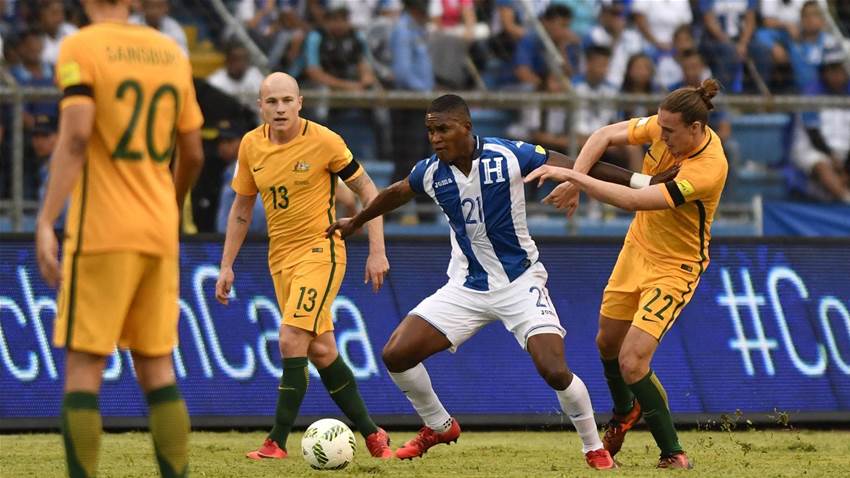A change in Ange Postecoglou’s system saw the Socceroos dominate a pacey Honduras side, coming away from the tricky away leg with a clean sheet, but no goals.
Jackson Irvine (attacking midfielder)
Irvine performed something of a stability role from his advanced position, which was able to give rise to both the attacking and the defensive aspects of Australia’s general play. Firstly, the fact that there is a single attacking midfielder in itself provides a point of difference compared to previous systems, with more space being left vacant on that line of play.
Both Mooy and Luongo consistently applied themselves in this regard, looking to exploit the space either side of Irvine when the ball was in suitable positions, as seen below. Instead of engaging the back four directly and trying to get in behind himself, Irvine usually maintained his position and allowed others to perform this function instead, preserving his goal-scoring threat in the middle of the pitch.

Luongo attacking the space next to Jackson Irvine, triggered by deeper location of the ball.
Irvine’s positioning facilitated the above movement, which eventually resulted in a few chances for Australia throughout the match. Irvine himself also offered another outlet during build-up, appearing in a passing line in the vacant spaces when one of the centre-backs or Jedinak were on the ball.
This movement placed him between and behind three lines of pressure – on the few occasions when this pass was able to be made, Irvine posed an immediate threat and endangered the structural integrity of the Honduran defensive block.
When Australia were without possession, Irvine was also responsible for pressing the player on the ball in an attempt to prevent the long ball, as illustrated in the diagram below.

The pressing system of Australia: Luongo and Mooy marking, Irvine towards the ball with Jedinak screening.
His pressing occurred immediately after loss of possession, and ensured that Mooy and Luongo quickly transitioned towards their nearest opponent to restrict the options going forward. Juric would apply backwards pressure, and if Irvine was not able to reach the ball in time, Honduras would attempt to play a long pass. Overall, Jackson Irvine acted as somewhat of the glue that helped to combine the dynamics of the Australian midfield diamond, a tactic which certainly appeared to have worked for Ange Postecoglou’s men.
Conclusion
A switch to a diamond midfield saw a clean sheet with Honduras’ chances being significantly limited, but a number of missed opportunities at the other end saw in a 0-0 result. Australia will be hoping for a win in Sydney in the return leg – if they do that, they’ll be on their way to the World Cup.
Nathan Muir is an Australian tactical analyst and coach. You can contact him on Facebook @NathanMuirFootball or on Twitter @NathanKMuir.
Related Articles

Champion A-League coach set to join Premier League giants

Under the gun: Spurs fans want Ange to be a loser in night of spite













